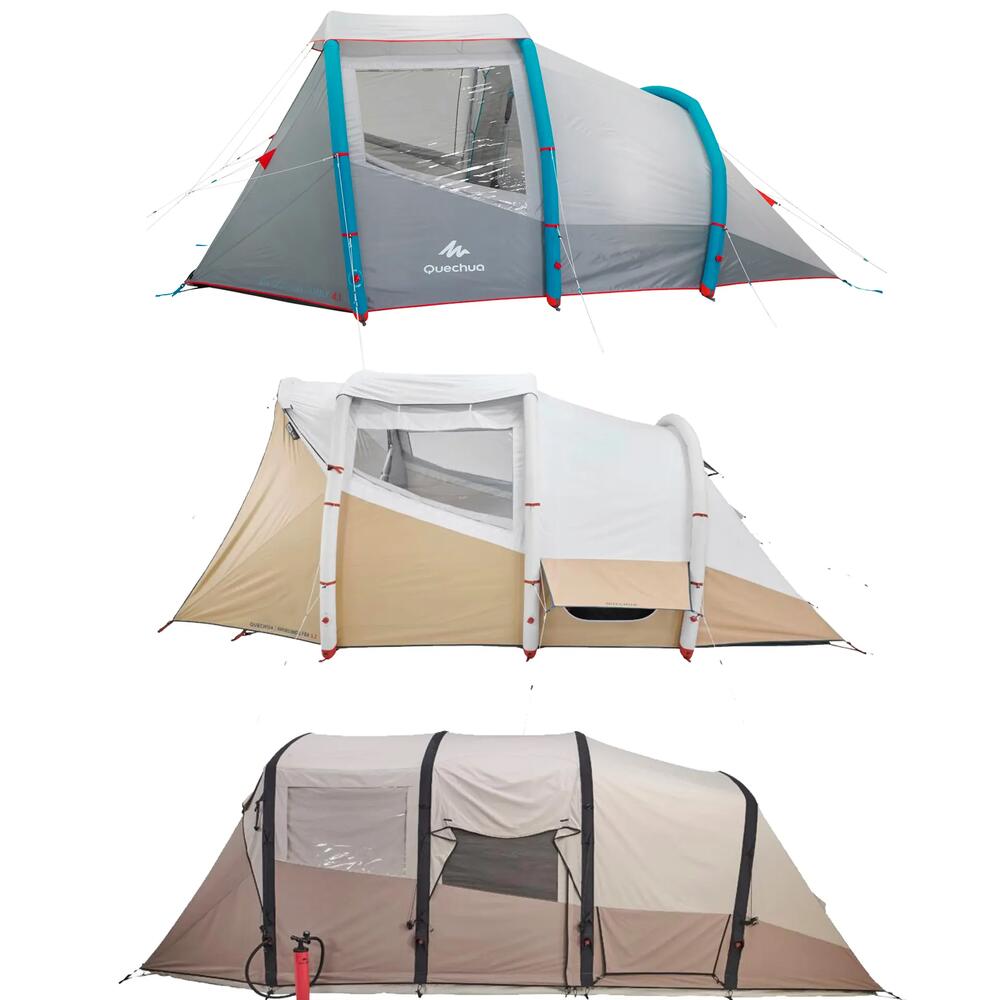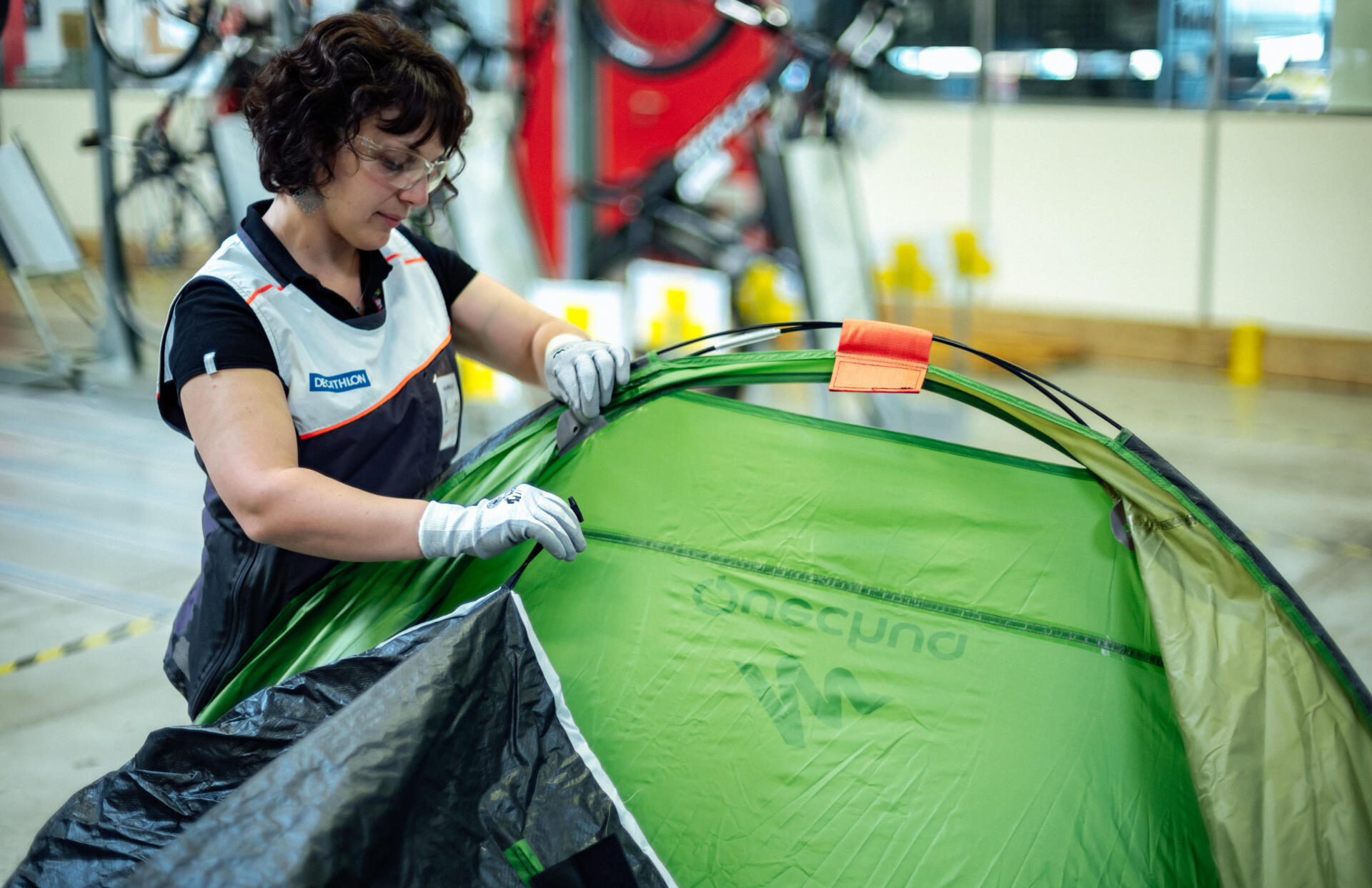Pitching my inflatable tent
Find the assembly videos specific to each tent model below!

REF: 8384152, 8513475, 8572950, 8584565, 8584571
You've bought an inflatable camping tent and you have a question or have encountered a problem with your model? Don't worry, we are here to support you.
This information is compatible with all our Air Seconds tent models, regardless of capacity.
Find the assembly videos specific to each tent model below!
AIR SECONDS 4.1 - 4-pers - pitching
Check out the tent striking videos specific to each tent model below.
AIR SECONDS 4.1 - 4-pers - striking
Download the Decathlon Camp app as soon as possible and find all the tutorial videos on how to pitch and strike your tent.
To avoid any unpleasant surprises when you get to pitch your tent, it's a good idea to carry out a few checks so you can set off with peace of mind.
- Take your tent out of its bag to air it and reduce any bad odours, and clean it if necessary (see our maintenance advice below).
- Check the condition of your equipment: make sure that none of the tent poles are broken, that the guy ropes are not faulty, that you are not missing any tent pegs, etc.
- Examine the fabric and the groundsheet to check that there are no holes
- Check the condition of the zips to see if they are working properly
Before pitching your tent, it is essential to choose an appropriate spot. So, we have listed some tips to help you find the perfect spot :
If you have a pitch:
- Do not pitch your tent near the entrance, restaurants and activity centres of your campsite in order to get as much peace and quiet as possible.
- Check out the neighbouring pitches to make sure you aren't next to a summer camp or a large family that could be very noisy.
- Prepare a sufficiently large area outdoors if you have children so that they can let off some steam
- Check your pitch to see if there are any stones, branches or other objects that could potentially damage the tent
- A shaded area is preferable if the period when you are leaving is very hot
If you are wild camping:
- Look for a flat, relatively clear area (no stones, branches, etc.) to sleep well and not damage your tent
- Do not pitch tent too close to water. There are a number of reasons for this: humidity, insects, the water level can rise up, etc.
- Reduce the exposure to the wind so that you don't get buffeted and opt for a relatively sheltered location, e.g. near undergrowth.
- Always place the entrance of your tent away from the prevailing wind
- When it's cold, find a location that is exposed to the morning sun to avoid getting too cold.
All our tents are tested in the laboratory to validate their waterproofing: an initial test is conducted under a 200 L per hour per square metre shower of water for three hours. The second test is carried out in real-life conditions by our experts.
In terms of wind resistance, our tents are also tested in a wind tunnel on a turntable.
To see the specific characteristics of your tent model, consult the product data sheets available on the Decathlon website.
Weather tests Air Seconds tents
Cooler and darker so that you can sleep better! Fresh & black is a technology patented by Decathlon which reflects the sun's rays and keeps the light out using specific materials. This makes it feel less hot inside the tent, and also makes it darker inside. To make the most of this technology, don't forget to air the tent in the evening!
Polycotton tents have many benefits:
- better resistance to UV light
- more breathability
- more durability
- more lightweight
Warning: polycotton is a more delicate fabric when compared to other fabrics, so take special care when drying and cleaning it, in particular. Check out all our maintenance tips below.
Whether it's repeated rainfall throughout the day, persistent warm air when it's cold outside, body heat, etc. all of these factors can create condensation inside the tent. To prevent this, here is some advice:
- Open up the vents of the tent as much as possible, even when it's raining
- Do not creating any creases when pitching the tent, as this can cause water droplets to accumulate
- Do not pitch the tent too close to water. Instead choose a sheltered location where the temperature and humidity do not fluctuate as much.
To remove any condensation that may already be present, gently wipe off the droplets with a cloth and air the tent as much as possible. Open the door and put it in a dry place so that it dries out.

Using it correctly
Before pitching the tent, leave the front door closed so that the fabric does not stretch too much when you set up the tubes. What's more, do not tighten the guy lines too much, because excessive tension on the fabric can damage it. Finally, do not leave the tent too exposed to the sun because UV light causes premature wear.
Cleaning
Do not use cleaning products to wash the tent. Instead use clear or soapy water if necessary. Thoroughly rinse the product when you have finished.
For polycotton tents, clean the fabric frequently and remove any stains as quickly as possible.
Drying
It's important to dry your tent thoroughly after cleaning to prevent mould from forming. Polycotton tents require extra care and must be completely dry when stored.
If you have enough space at home, pitch it completely and open all the doors so that it can dry more quickly. If, on the contrary, you run out of space, detach the pieces one by one and extend them.
Finally, remember to also dry the bottom of the tent, as well as its bag.
Storing
Store the tent in a dry place at room temperature. Remember to close the front door properly so that the tent is not too taut when you pitch it again.
Restoring the waterproof properties
Several factors can affect the level of waterproofing of the tent, such as exposure to the sun, friction in the bag or even natural wear and tear.
Consequently, we recommend that you apply a waterproofing spray on the fabric and the groundsheet at least once a year.
Take advantage of the expertise of our employees and book an appointment online to benefit from the following workshop service.

Replacing the flysheet
Choose the model of your tent and find all the compatible spare parts so you can carry out the repairs yourself. To repair the poles, there is a diagram that you can use to identify the faulty part and find out the correct length.
VIDEO REPAIRS
In the following videos, you will find all the explanations you need to carry out the various possible repairs.
Air seconds inflatable tents: assembly, instructions, maintenance, repair
A RIP HAS FORMED IN MY FLYSHEET OR MY BEDROOM
You just need to apply a patch or adhesive to fill the hole. We recommend that you apply them on the inside of your flysheet or your bedroom for better adhesion.

Self-adhesive repair patches

Self-adhesive repair tape

